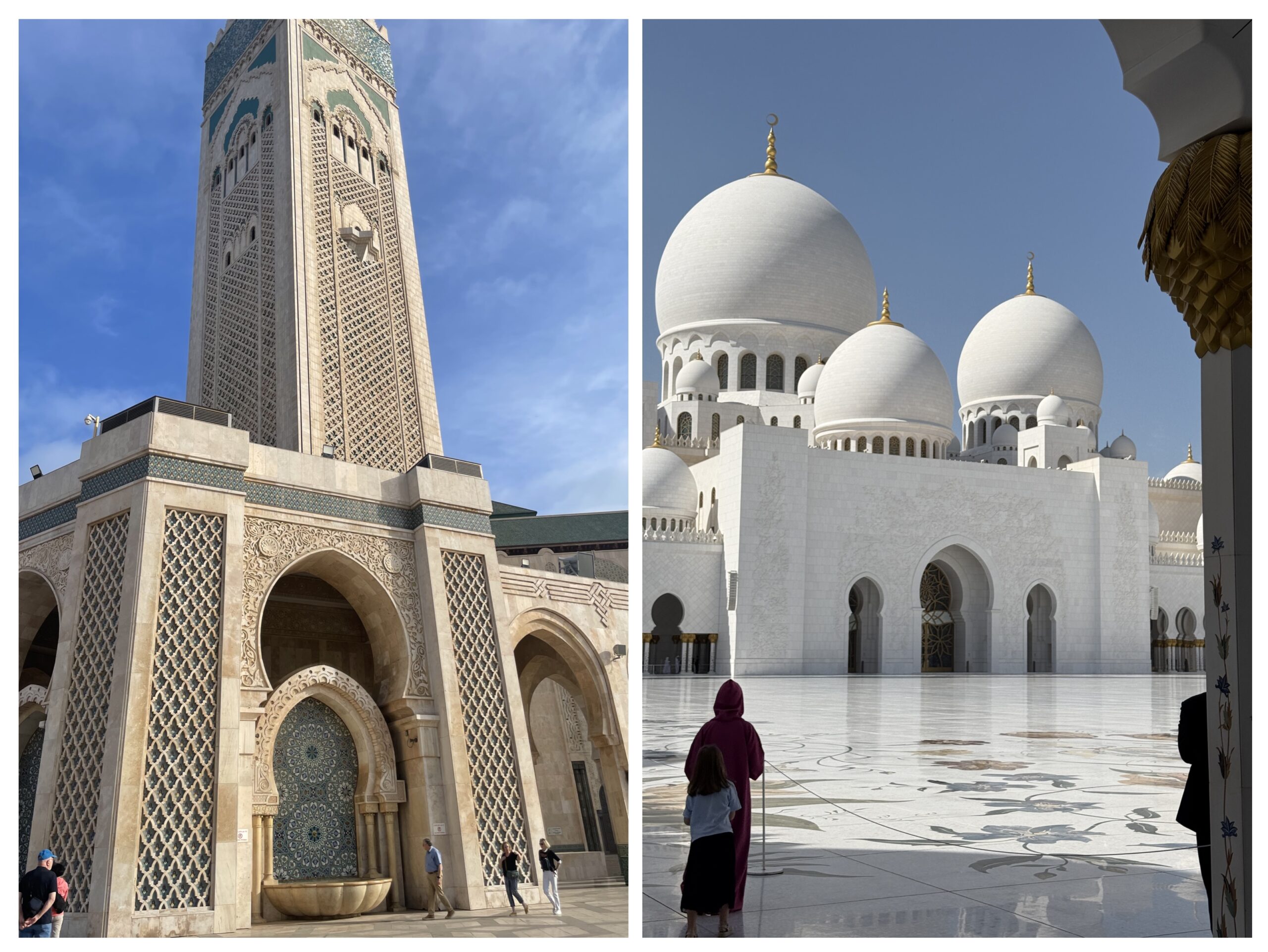As the Turkish Airlines 777 banked over the Black Sea, on approach to landing after an overnight ten hour flight, an announcement congenially welcomed us. “Ladies and gentlemen, and dear children, welcome to Istanbul, the crossroads of the world.” We knew we were in a different place. No airline in the Western world would think of welcoming children. It was a hint about modern Turkey: the gift of location, a struggle between the traditional and the modern and aspirations of resurrection.
I recall as a child searching for “Constantinople” on the map after learning about its splendor and importance, only to give up and assume the city was gone. But it is still there, now named Istanbul, a name with many origins depending on who you ask–perhaps a kind of mash up of “Constantinople”; derived from the Greek is-tin-poli, or “in the city” or even, as the current President Recep Erdogan said, “This is Istanbul, also known as Islambol, or ‘full of Islam.’”
Before this trip, “Istanbul” conjured up many images – of smoky alleyways, men and moustaches, colourful head dress, tunics and gold, women in burka and niqab, spires, minarets with circling birds, and the headland of the Golden Horn with patient ferries plying the waters. On the drive into Istanbul, I kept expecting to drive into warrens of old buildings and bazaars. But instead, we passed endless forests of pine and empty hills with few, if any buildings. It felt like Canada. When we reached Istanbul, there was a forest of mosques, one every block or two each with at least a single minaret, but to my eye, Asia had not begun; in many ways much of Istanbul did not look that different from Europe. Indeed, Turkey is rushing headlong into the modern world, with a per capita gross domestic product only 30% lower than Europe.
Still, there is much about Istanbul that astonishes and delights. The epic tapestry of the story of Istanbul, from its birth in 330 AD as Byzantium (preceded very likely by Neolithic revolution habitation), transformation to Constantinople under the Romans and the glorious Ottoman Empire is likely without equal, and the city still bears the marks of its long history.
Our hotel, a converted ship’s captain’s house from the early 20th century was full of winding, short stairs. The room, elaborately painted with gold crown molding, fronds and bunches of grapes. The first morning in Istanbul, we heard the long, mournful call to prayer, the Ezan as it is known in Turkey, at five am. Today, electronic amplification aids it, creating a bizarre effect, with multiple mosques competing, with the buzzing and hissing of speakers. The morning Ezan was especially melodious, and pleasant to listen to — that is, if you ignored the hour.
The call to prayer is exactly that, a call exhorting Muslims to come to the mosque. It sounds poetic and mysterious, but in truth is prosaic:
God is Great
There is no god but God
Muhammed is the Prophet of God
Come to prayer, Come to salvation
God is Great
There is no god but God
For the indolent, the day’s first prayer slyly inserts: “Prayer is better than sleep.”
One windy, cold day we made our way to Taksim Square, the heart of Istanbul. Frigid, windswept and desolate, and as much out of curiosity as an attempt to escape the raw weather, we went into an exhibit on Gaza set up in a tent. The installation recreated a war zone, with bodies, blasted chunks of concrete with rebar hanging out, broken dishes, dolls, and the shattered detritus of domestic life. It detailed the stories of lives lost, of children maimed. The installation pre-dated the current invasion of Gaza. Its intent was clear–to paint a picture of a cruel Israel assaulting an Islamic country. Many in the world, and certainly in the Islamic world, that would paint it the same way. Islam in the modern world has come to be the face of anti-Westernism, joining an uneasy alliance of Russia, China, and India.
I asked about the strength of Islam in Turkey, hearing the calls to prayer five times a day in Sultanamet, the old city. “Twenty percent are practicing Muslims. Sixty percent go to the mosque once or twice a year. The rest don’t have Islam in their lives. But with the current regime, it is fashionable to appear devout.”
Turning out of the hotel we strolled past the Blue Mosque, or more properly, the Sultan Ahmet Camii, which is “the most overrated attraction in Istanbul,” we were later told by our guide. Armed guards were everywhere–that is, 23 year old men, with the ever present Turkish mustache, holding sub-machine guns. The Israel-Gaza conflict had created widespread uncertainty in the Islamic world. When walking with my wife, the guards paid no attention to us; later, when walking through alone, I felt every eye trained on me.
There is no shortage of ancient and impressive sights in Istanbul. We examined the Yeni Camii or “New Mosque” dating from 1665. Its domes and intricate scrollwork are more impressive than the Blue Mosque itself, as our guide had intimated. Inside, on the rainy day we visited, we gingerly removed our shoes on webbed green plastic matting, remarkably effective in keeping our socks dry. In the cavernous mosque, men kneeled in the mihrab, the niche at the front where the prayer is being led by the imam. Women remain behind a barrier, a full 50 feet from the kneeling men – the same place we stood. Distance from prayer seems to have reduced the religious zeal of the women, since at least half were spending the time scrolling on their phones, unlike the men who bowed in a posture of absolute devotion. This mania for phones was widespread in Istanbul – I’m aware that phone obsession is the case everywhere in the world, but the Turks have raised it to a noticeably higher level, virtually always glued to their screens, whether they are on the streetcar, smoking a hookah, drinking tea, walking on the street or praying in the mosque. Even the carpet hawkers tear themselves away from their phones just long enough to call out, “yes sir, yes sir, good price, no buy, just look” as you pass by.
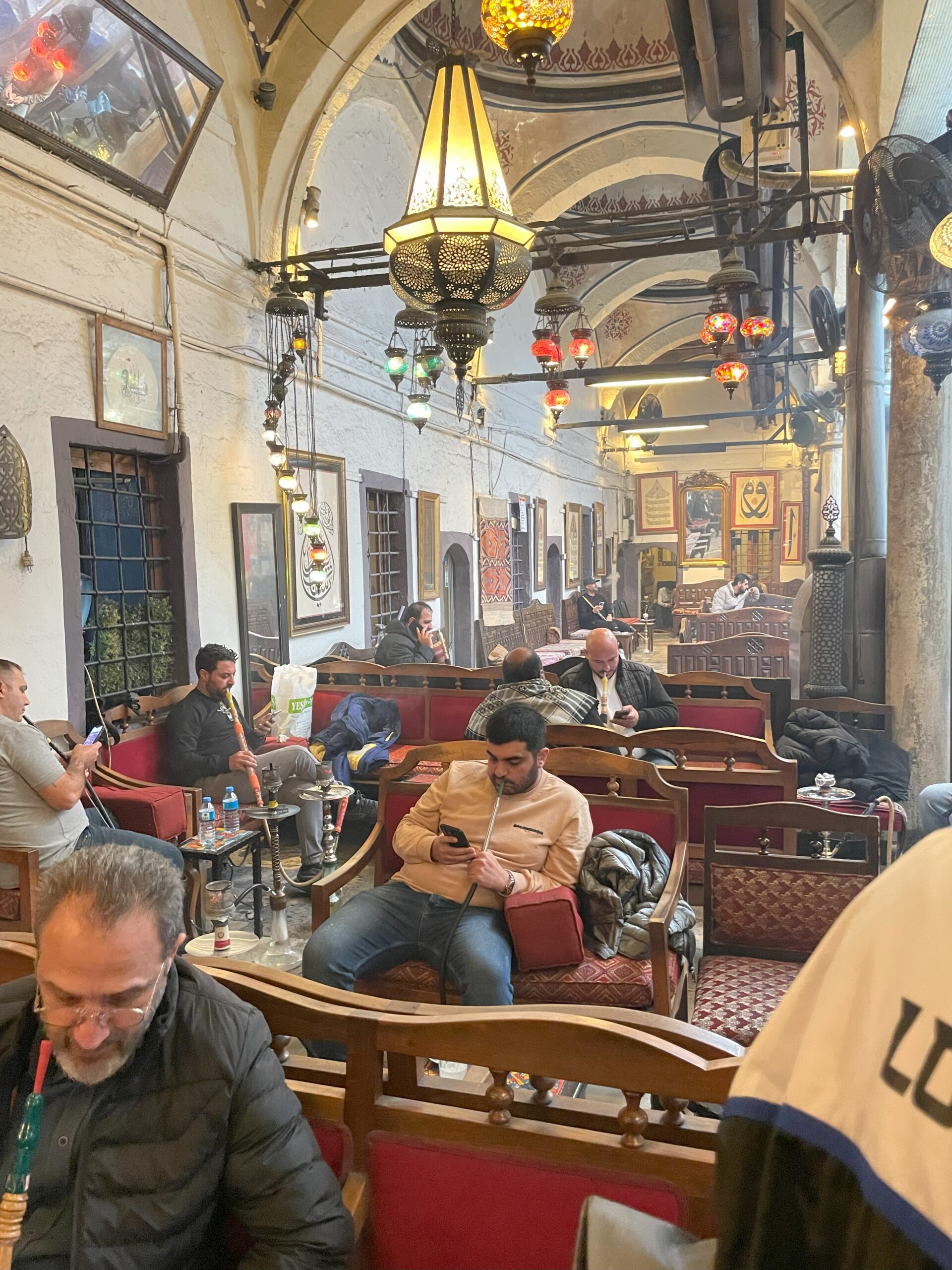
The ancient Basilica Cisterna is a subterranean triumph in this former capital of Byzantium. Its name, Basilica, is not derived from being a place of worship or government, but simply because it was constructed beneath one. Fashioned from repurposed capitals imported from around the Roman Empire, creating a kind of elegant odds and ends, framed by Roman arches, a thin layer of water on the ground glows with light as you walk along the long rows of columns. The beauty and care that went into constructing what is essentially a utility beneath the ground — the municipal water supply — strikes one. In fact, among the sights of Istanbul, I found it the most stirring–its age, from the 6th century CE, its Roman architecture, and its demonstration of Roman power here at the eastern edge of the Empire.
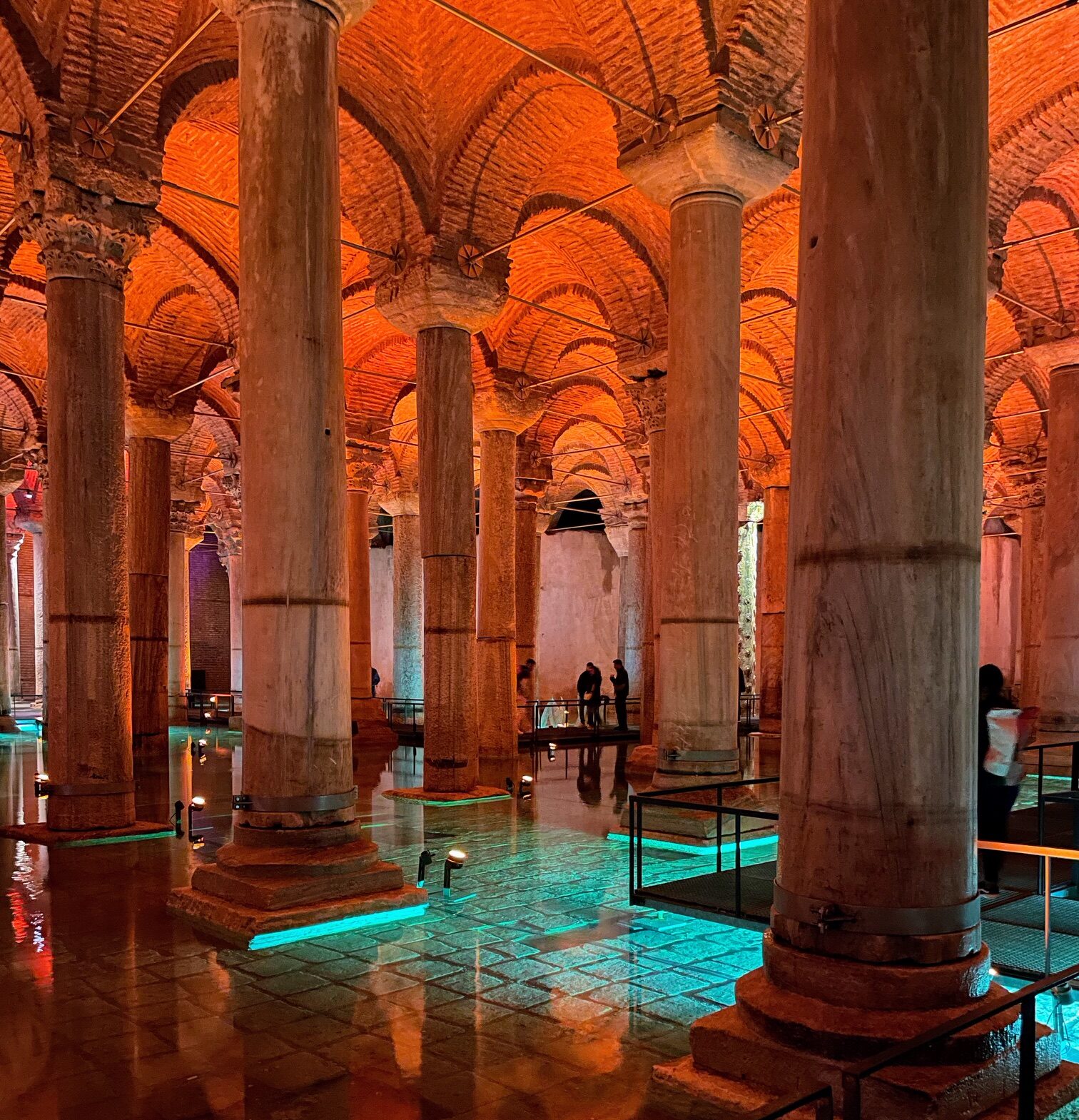
One day, walking about in the rain, we kept noticing people wearing nose splints. In addition to the splints, faces had large patch bruises, purple and blue, sometimes exploding around the eyes, racoon like. We thought perhaps the night before there was a magnificent brawl. Yet they were going about their business peacefully, with no apparent concern. It turns out Istanbul is the nose-job capital of the world. Actually, one of a few–apparently Tehran, Baku and Yerevan also share this notoriety. Hair transplants as well–many otherwise bald men appeared to have had furrowed rows of reddish rice grains machine gunned into their heads, which were in fact the plugs of newly inserted hair, moved from another part of their scalp. Istanbul surgeons are ardent competitors–they lay out the red carpet for guests, paying for accommodation and even tours while they receive their new noses or head of hair–or both. Their reach is long. Even in Toronto, cosmetic surgeons, nervous about the transcontinental competition, feel compelled to advertise that they are as inexpensive, or better than the ones in Istanbul.
Judging by the wares offered in the markets, the Turkish passions are drinking tea and coffee (with innumerable varieties and apparatus for sale), eating Turkish delight (I cannot imagine all the shops are for tourists), fresh fish (rightly so), and all kinds of interesting breads. There is also a thriving market for reproduction purses and leather ware by Gucci, Louis Vitton, all very well made. The reality is, “original” Italian leather goods are made in sweat shops in southern Italy. Some manufacturers produce them in China, taking advantage of a convenient Italian law that permits the use of the “Made in Italy” label if two manufacturing steps are carried out in Italy. Affixing the label is probably one of them. So it may well be the conditions and quality of work are the same or higher in Turkey.
 What is Turkish coffee? It has only passing similarity to espresso and dates back to the Ottoman empire. Drank later in the day, not as a breakfast drink, it is a ritual as much as a drink. I suppose this is owing to the necessity of sipping it slowly, lest you get a mouthful of fine grounds. While I am an ardent fan of the bean, I never warmed to this slurry sludge. But the cups it is served in are tiny works of cottage art, with elaborate scrolls of blue and red, barely fitting two ounces, smaller than espresso cups. The Ottoman cups have no handles, with the cup held like chai is drank in India, or mint tea in Morocco – by the fingertips.
What is Turkish coffee? It has only passing similarity to espresso and dates back to the Ottoman empire. Drank later in the day, not as a breakfast drink, it is a ritual as much as a drink. I suppose this is owing to the necessity of sipping it slowly, lest you get a mouthful of fine grounds. While I am an ardent fan of the bean, I never warmed to this slurry sludge. But the cups it is served in are tiny works of cottage art, with elaborate scrolls of blue and red, barely fitting two ounces, smaller than espresso cups. The Ottoman cups have no handles, with the cup held like chai is drank in India, or mint tea in Morocco – by the fingertips.
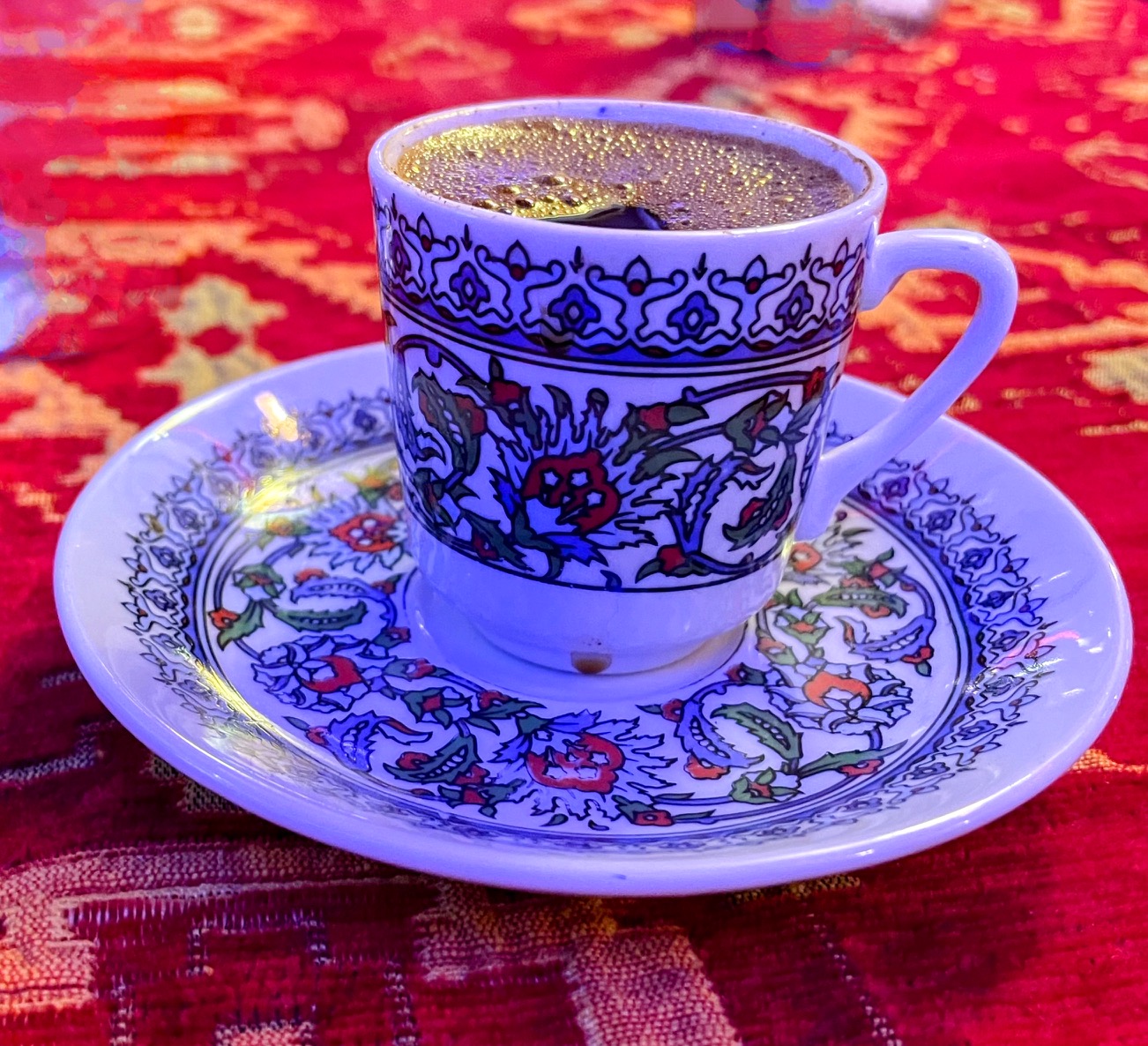
Tea is drank in innumerable cups during the day, served in small, delicate tulip shaped glasses, like a small New Orleans hurricane glass. A large portion of markets are devoted to selling dry tea leaves, invitingly displayed in square wooden boxes, in an array of colors and textures, and smells, pinks, lavender purple, golden yellow and rose and green. Energy has dried slices of pomegranates, apples, cinnamon and raspberries, the ubiquitous apple is golden brown dried pieces of apple, black tea and saffron has black and saffron yellow specks, There’s a myriad of others, named only for their effect – Relax, Stomach, Cholesterol, and Love. And of course, “Hurrem Sultan”, the name of an enslaved girl, born in the Ukraine, who rose the ranks to become the Ottoman Sultan Suleiman’s wife in the 1500s.
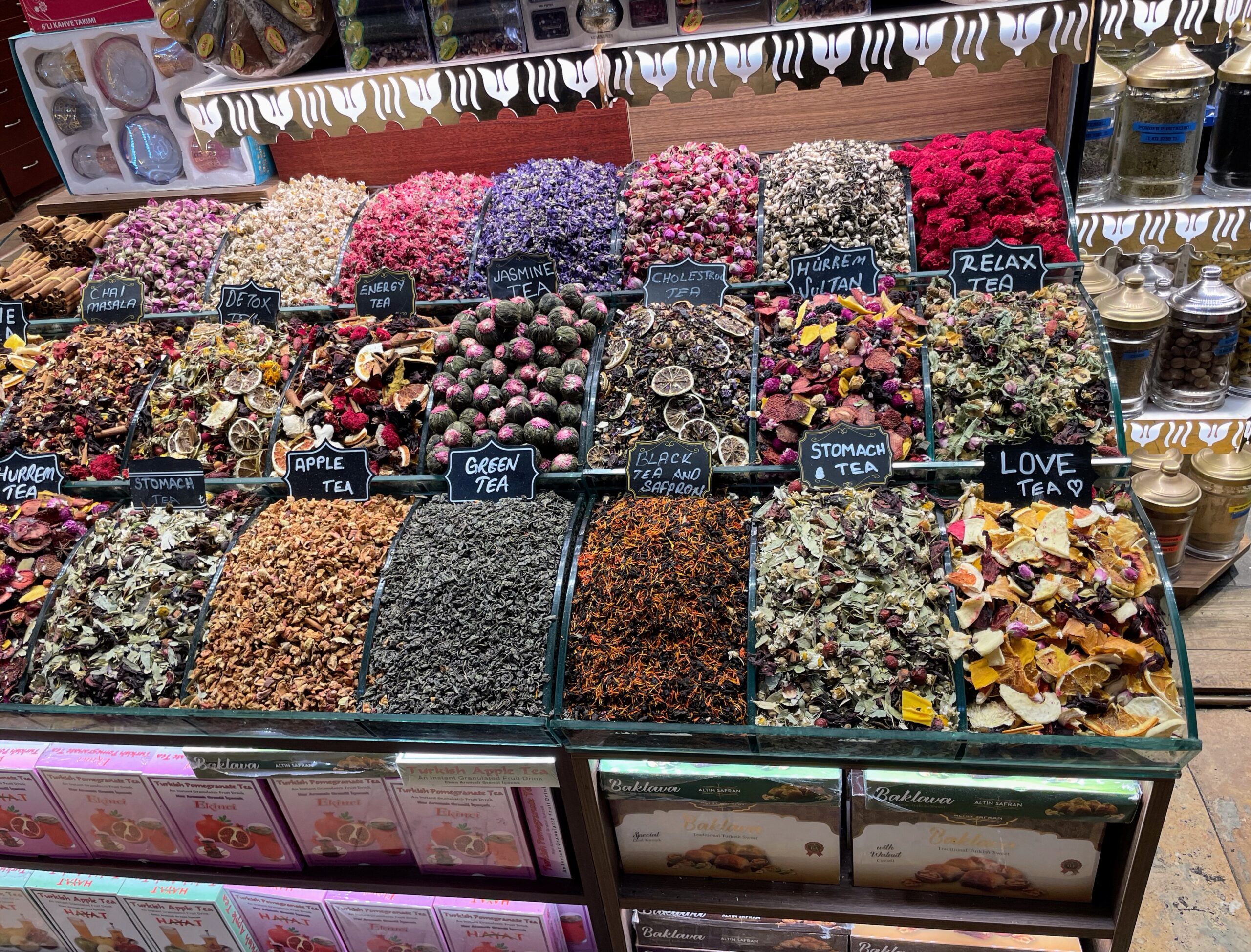
Turkey, like many countries in Asia places great value on family. It is the essential social unit, and most families care for each of their members without the insistence on independence so prized in the West. The village idiot and the town drunk are lost forever in the western world. This may not seem like a great loss, but he or she was the struggling person, perhaps with mental illness, perhaps with addiction, that was tolerated and, in a sense, cared for by the “village”. That station in life is no more, and instead this band of misfits has become the street homeless, the deeply addicted, and because of tainted opioids, the dying, in many cities in the West. It is not just poverty, although the western world is cruel to those who don’t join the capitalist march. The streets of Istanbul have very few panhandlers, homeless or drug addicted. When I asked, I was told simply that such peoples’ families take care of them. Their village takes care of them, not the streets.
Cats, cats everywhere. On the street, on balconies and roofs, in houses, on houses, in shops, lying on books in a bookstore. Fed by local residents, in each neighbourhood, we had a whole … “clowder” of cats, I am told, is the collective word, stationed at the end of our block. Neighbours feed them, and cats show up at an appointed hour to receive food, making them more sleek and well nourished than in other Islamic countries. There is a story, apocryphal no doubt, that the Prophet Muhammad cut off the sleeve of his garment off when he heard the call to pray rather than his disturb his cat, Muezza, who had fallen asleep on his arm. The modern Turkish cat also owes his indulged existence to the Ottomans, who worshipped cats for their cleanliness. One storm tossed and rainy night we dined at a nearby restaurant with several cats roaming about. A small black one established himself on the red velvet banquette beside us. Fair enough, we thought, he’s not bothering anyone, until he launched himself at, and helped himself to our dinner plate, securing a mouthful. This was his successful third effort. Now I have nothing against the Ottomans, or local customs, or for that matter, cats, but dining off the same plate with one was taking things a bit too far. We swatted him away and called the waiter over. We expected the creature to be turned out of the restaurant at once. Nothing doing – the he smiled faintly and shuffled his feet.
After hesitating, he brought over a spray bottle of water, saying, “Use this”.
I recalled cats hate water. What they are doing in Istanbul in January I don’t know, as we were rained on more or less continuously. The spray bottle was deployed with devastating effectiveness, and we handed it to the patrons next to us when yet another cat began his predations on their dinner.
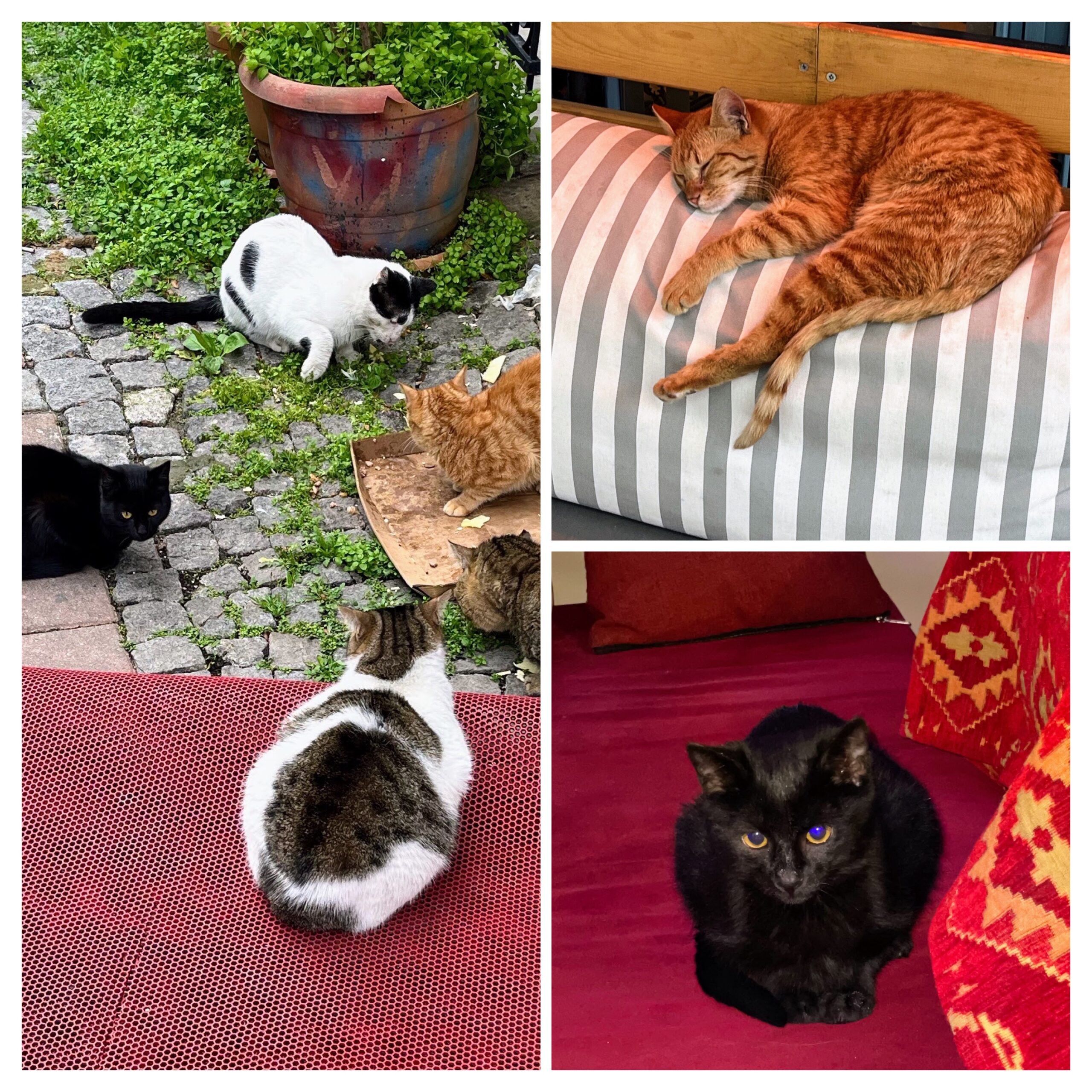
One experience, both ancient and quintessential to Turkey, is a visit to a traditional Turkish “Hammam” as bath houses are called. The whole affair is now modernized, with online bookings. Our guide recommended the most basic, the 60 euro “Istanbul Dream.” On a cold, wet and windy night, I made my way across the deserted large square in front of the Blue Mosque, silently watched by the machine gun armed guards. I presented myself at the reception desk, underneath a soaring white marble vault at the Cağaloğlu Hamam, constructed in the 1700s. Stars and shapes punctuate the high domes to let in the light. Small glass domes, called “Elephant’s Eyes” cover them from the outside. After undressing (completely) I was led into a magnificent vaulted room, entirely constructed of white marble with grey bands, the marble “beds” placed in an octagonal pattern below the central vault. Steam and warmth welled up the sides, across the floor, the sounds muffled by the thick air. I am always a little nervous in spas and feel vulnerable. Here, buck-naked, surrounded by Turkish attendants, in a foreign country, I was even more uncertain of what was to come next. First, I was led into a small stone steam room, again all in marble with its own arched dome. There were a group of young Russian men, short and stout, speaking in guttural tones to each other. Sitting among the steam, which was not particularly warm, I grew tired of it, and ventured out. My attendant immediately saw me and led me over to a kind of marble massage table, ornately carved, with curving legs, all in one piece. Did I say I was nervous? The table, absurdly, reminded me of marble slabs on which corpses were laid out for autopsy, from an Emile Zola story set in Paris. A sneaked look around the room showed at least one patron on a table, looking thankfully, alive.
At this point, I thought that I needed to get a hold of myself — after all, I paid for this and was supposed to be enjoying it. I briskly climbed onto the table, despite it being slick from steam and hot water, which the attendant had poured on it, presumably to bring it to a comfortable temperature, hoping I didn’t shoot off and onto the hard marble floor (well anywhere, the whole room was marble). There I lay then, waiting for what was to come, my body pressing into the slight grittiness of the slippery table beneath me. The attendant, dressed in white cotton, poured several warm buckets of water on me with a copper bucket, from a sort of warm water fountain nearby. The steaming water had a smooth and viscous feeling, enveloping me in comforting warmth. After the warm water, the attendant donned a white glove and mentioned he would be rubbing me down to clean my skin. Well, this “kese” glove as it is called, was in fact a raspy surfaced instrument of torture, something like a cat’s tongue. Now I was reminded of another story (maybe I should read less) by Jack London called “Mauki” about a south sea island native slave whose white master used a ray-skin mitten, coarser than sandpaper or shark skin, to inflict pain upon Mauki by raking him with it, scraping the skin right off. That should give you and idea of what this white mitten felt like, though obviously this was intended to perform the more genteel, but apparently necessary process of “exfoliation”, a term known to avid spa goers. This mitten was applied thoroughly, and to all areas of the body, with the clear intent of denuding my epidermis, while I silently prayed that he would exempt certain areas, which he mercifully did. The abdominal sections were particularly trying. Then he asked me to turn over. Try turning over on a wet marble table. It feels undignified. He hit pay dirt on my back, even stopping to proudly show me the dark skin cells he had scraped off my back. Then we went on to copious amounts of water again – less soothing this time as I was raw from the mitten.
Now I was piled high with white suds, to a height, it seemed of two feet. I was sealed inside this white pyramid, marveling a little that it stood there and didn’t slip off. I dared not open my eyes to avoid getting soap in them. Then using long strips of cotton, the suds were squeezed off me, like skinning a vegetable by grasping its skin. This involved a lot of pressure, to be clear. This concluded, a massage began. Not exactly a massage, more like trying to force the blood in my limbs heart-ward, with chops on my back and belly – a kind of Hollywood caricature of a massage, punctuated by yells and groans – both the attendant’s and mine. I was getting a little exhausted by now and welcomed the final warm rinse off. I rose from the platform a little unsteady and slipped on the slick floor. Long accustomed to stuporous clients, I was quickly righted and escorted to the “recovery” room. There I lay, now in a warm aura, skin glowing with heat, muscles relaxed, mind at ease in a tranquil haze, whether from the relief of being released, or the bath itself I cannot tell. I sat once again under the large marble dome surrounded with balconies and arches and given two small tulip shaped glasses of pomegranate and black tea and two small dice sized cubes of Turkish delight. Then with a small bag of lotions, I stepped out into the cool, rainy Istanbul night. Back at the hotel my wife asked how it was. By that time, I was feeling dreamy and serene.
“It went well. You should try it sometime.”
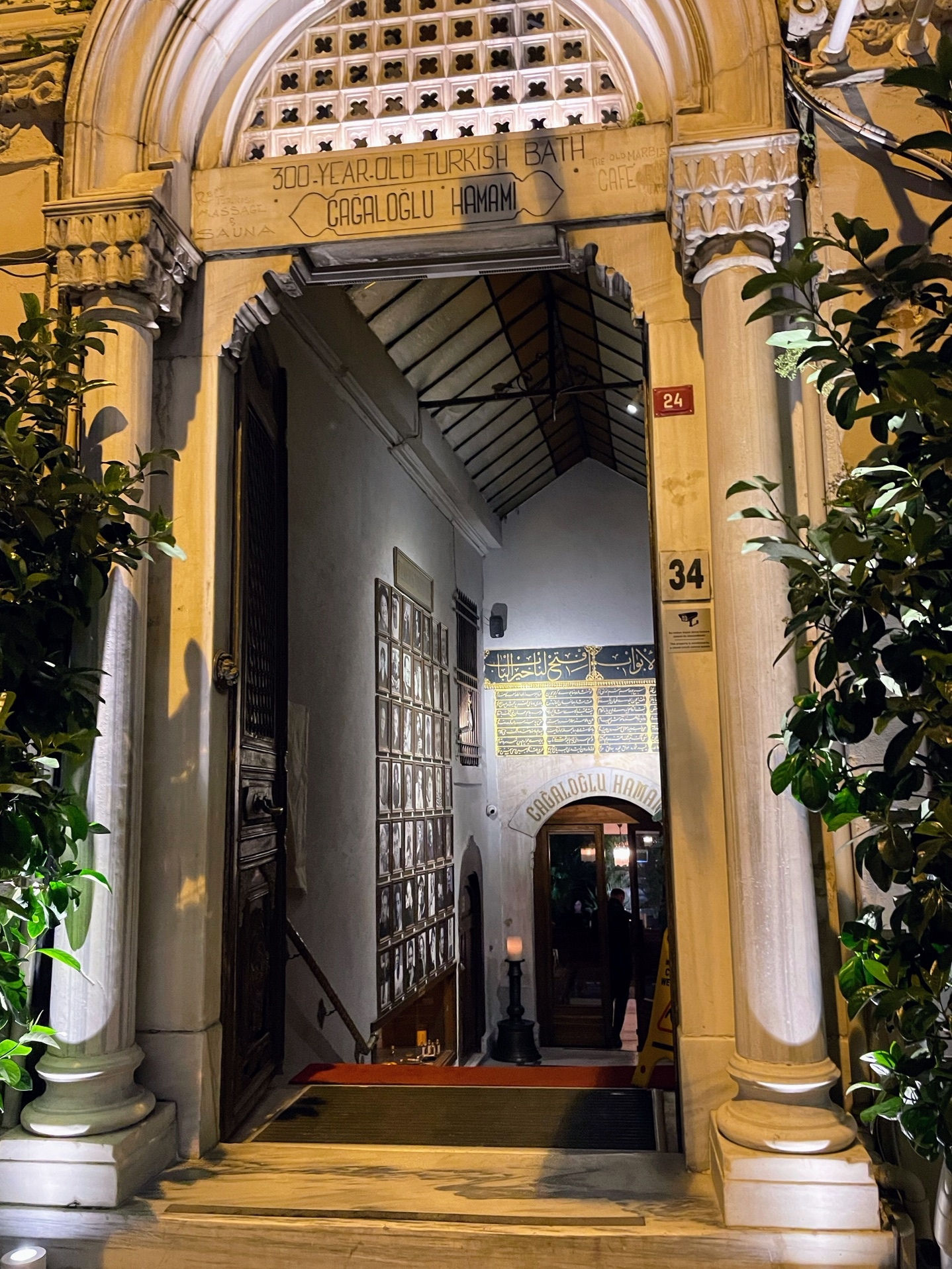
It is a curious fact that +8 degrees Celsius in one country can feel colder than -10 in another. Time and time again – London in November, New Orleans in December, San Francisco in July I have felt a damp chilliness, colder to me than Toronto at temperatures almost 20 degrees colder.
Why could this be? Of course, the traveler is always a little sleepless, and tired. He also is far better equipped to dress properly in his home country. He anticipates the impact of rain, humidity, wind, sun on his comfort, and has at his disposal all the right apparel. And in any case, he returns to the comfort and warmth of his own home whatever the weather. Despite being a cold country, Canadian homes exquisitely regulate the environment regardless of the exterior weather – unlike the rest of the world. As a result, when we stepped off the plane a chill set in that lasted to the moment we left. I would not like to say that rain and cold were the lasting impression that I have of Istanbul, but in some ways it was. Through a haze of mist, rain and cold, we viewed the Blue Mosque, the Hagia Sofia. The Topkapi Palace saw us huddling in corners, a bitter wind whipping, as we bent through the immaculate grounds. We saw the Bosphorus through rain, slanting sideways.
Visiting a place in the off season has its charms, however. Paris in March is wonderfully authentic, if cool and wet, the cobblestones glistening at night, and the damp air mixing with the smells of coffee and cigars in the morning. The crowds that will be unleased in May, belching forth from metro stations and hotels have not yet arrived. In the same way, we found Istanbul in a low and relaxed state, with empty restaurants, few line ups and locals taking their time with us.
The Ottoman empire must count as one of the most ambitious, bloody, rich, perhaps despicable and sumptuous ones in human history. With wars, multiple genocides, and fabulous wealth and reach, it is truly an epic story. The empire was slow to die. From its birth in the 12th century to its zenith in the 15th century to its final demise in 1922 , it was a long and leisurely decline – over 600 years – compared to the 400 years that the British Empire reigned. The Topkapi Palace, not far from the Blue Mosque, holds some of the fabulous treasure, jewel encrusted daggers, swords, fabulous glittering chests and rich clothes with sewn golden threads.
Orhan Pamuk, the Nobel winning Turkish author, in his book Istanbul, about his childhood in Turkey makes a realization that his family is in fact a slowly dying ember of the Ottoman empire, with its creaking family members, seemingly museum-like apartments, stultified relationships, forgotten memories of status surrounded by a changing Istanbul convulsively flapping from modern to traditional.
The Ottoman empire may be a dying ember, but Modern Turkey has ambitions of its resurrection. It has swung from Christianity to Islam, to secularism and back again. The Hagia Sofia, one of its most famous buildings, has stood stoically since 537 CE, silently enduring the changing seasons of the country. First founded as a byzantine church, Mehmed II in 1453 changed it to a mosque, adding a requisite minaret. In 1937 it was secularized and made a museum, but in 2020 the current President, Erdogan, made it into a mosque once again. Moodily viewing the expansionist mood in Russia, seeing a weak and easily bullied Greece, and latching on to the bandwagon of religious fundamentalism like leaders in India and the US, he has striven to restore Turkey’s ambitions as a modern Islamic power. It has invested heavily in its military, with the second largest standing armed force in NATO.
Geography is certainly on Turkey’s side – the strategic location along the Bosphorus was a gift to the Byzantine and Ottoman empires; it is a gift to modern Turkey, especially in having influence over it’s belligerent neighbour to the north, Russia. It has maintained a prickly friendship with that nation. Turkey also strives to control the eastern Aegean, which Greece also asserts sovereignty over, irritating Turkey and continuing an age old battle between the nations, with Erdogan cautioning Greece to “mind its place” and “remember the history.”
Istanbul, the crossroads of the world.
The city is spectacularly situated, scenically as well as strategically. It ranks with the most impressively sited cities on earth – Vancouver, San Francisco, Sydney, Cape Town. The misty weather prevented us from fully appreciating the splendorous views over the Goden Horn and the Bosphorus. With minarets, old domed buildings, rugged shorelines, sharply sloping streets, colourful houses, and numerous antique ferries plying the waters, Istanbul is an engaging and fascinating sight, from almost anywhere in the city. Our guide took us to what he described as “the most Instagram-able location” just outside the Yeni Cami, but my camera only recorded grey fog and rain filled skies.
Istanbul stands at one of the great choke points of the world, along with the Straits of Hormuz, the Suez and Panama. It controls sea access to Eastern Europe, the Balkans and Russia, in addition to butting up against Greece and the Aegean Sea. The interior of Asia, the Mediterranean, the Middle East, the Levant – they all sit at Turkey’s doorstep. Like spokes around a wheel, it abuts no less than eight disparate countries around the compass of its borders. It is no accident that the Ottoman Empire, in this centrepoint of the ancient world, was one of the largest, wealthiest and most long-lived empires.
A modern version of crossroads: the vast route map of Turkish Airlines shows an unexpected ambition – to be a carrier to almost all nations on earth for global travel. We flew to Istanbul and on to Mumbai on Turkish, through the modern airport at Istanbul. The carrier serves more nations on earth than any other, and with the advent of long range airliners, almost all those destination are a nonstop flight from Istanbul. Emirates Airlines and British Airways serve less than 85 countries, while Turkish lands in 119 of 195 recognized nations on earth. Turkish Airlines serves even the ones less serviced by Western airlines. So, if you want to go from, say, Miami to Moscow, or Toronto to Tehran, it’s a one stop journey through Istanbul. Of course something like Denver to Dhaka is an effortless one stop too. No country is geographically better suited to be the air crossroads of the world, and the passenger numbers show it, with IST Airport challenging Heathrow and Dubai as a leader in international traffic.
The varied crowds in Istanbul are also unlike any I’ve seen in Europe. There were many Russians, their travel otherwise curtailed by the politics of their nation, visitors from the nearby Balkan countries, what appeared to be Iranians, Azerbaijanis, women with jet black hair and very pale white skin, almost jarringly so, along with redheads, perhaps from Georgia, with a few visitors from Europe and North America. We met several Koreans and Japanese, reminding us that we were as far from home ourselves as Seoul or Tokyo was from here. The crowds rattling against each other on the streets give one a feeling of being at a confluence of peoples and cultures, a kind of giant caravansary, harkening back to the silk road.
So there we leave these short four days in Istanbul, a handsomely positioned city at the crossroads of the world, ancient and modern, one of the world’s largest cities, bustling, prayer calls ringing out proclaiming its devotion to Islam, its markets teeming, having latched on to strange pursuits like cosmetic surgery, fake designer handbags, and an unnatural devotion to cell phones. I hope to return in milder weather to take in the many vistas the city offers and understand better this cauldron of peoples and history.
But tonight, lashes of windy cold rain chased us to the very doors of the plane, up the stairs to the Turkish Boeing 777 standing high above the airport apron. Its jets were idling, howling like a hundred bandsaws in unison, almost outdone by the wind. The gusty rain gave us a last slap as we ducked gratefully into the aircraft which would bear us overnight to Mumbai. At least we were going to a warmer country.
Details: to book the Hamam Cagaloglu.

